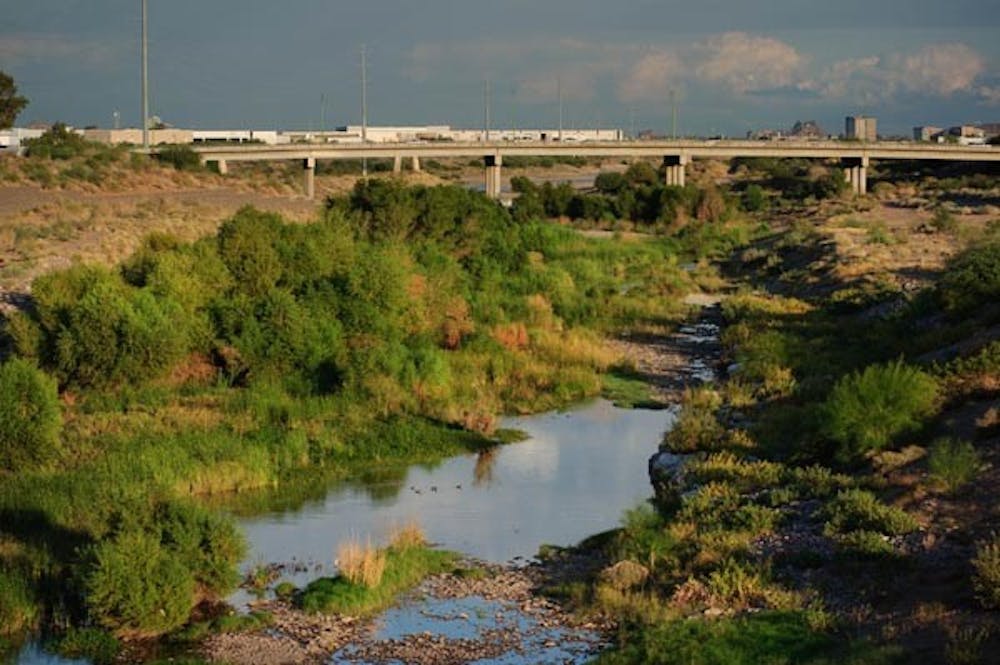 An ASU professor’s river research has global implications about the changes in the food chains in rivers around the world.
An ASU professor’s river research has global implications about the changes in the food chains in rivers around the world.
John Sabo, an environmental science associate professor in the School of Life Sciences, released a study Oct. 15 that focused on the interaction between water and biodiversity in rivers.
Sabo said the study showed that if a stream or river runs dry for two or more days in 20 years, the drought will eliminate all the large fish-eating fish in the river.
The other parts of the ecosystem, including the vegetation and the other kinds of fish, recover for very short-term droughts, he said.
His data included 36 rivers from across the United States.
Sabo’s study has received attention across the U.S. and internationally in Canada, India and Pakistan because the study revealed the heavy impacts of drying rivers across the world.
Examples of places that have been affected include the Yellow River in China and the Mary River in Australia.
This drying is due to increased human and agricultural use and the effects that can have on food supply, Sabo said.
As more and more demand is placed on the water supply, the study demonstrated people across the globe and especially the Southwest U.S. are going to have to make tough choices about water usage, he said.
The choices are going to have very personal implications for everyone no matter how committed to the environment they may be, he said.
“I like biodiversity, but I also like avocadoes and tomatoes,” Sabo said.
While Sabo said that reintroduction of predatory fish may be an option in some ecosystems, maintaining the Colorado River and other systems as they are may be the most practical option for Arizona because agriculture and household use relies on a limited water supply.
Unfortunately, Sabo said scientists cannot experiment on the river to find the best ways to preserve the native species of fish because people across Arizona rely on water and electricity from the Colorado River.
The Colorado River used to flood in the spring. Removing the flood levels changed the environment, making it harder for the native fish to survive, Sabo said.
Sabo said this raises tough questions for citizens of Arizona.
“How do we accept what nature we have left? Even harder, how do we accept what we have architected?” Sabo said.
Thomas Dowling, an evolutionary and conservation genetics professor at ASU, agreed that river management in Arizona is a complicated process because the need for electricity and water in Arizona is met in part by the Colorado River.
However, Dowling said he is going to continue to advocate for the Colorado River to return to a state as close to original as possible because many of the fish that are part of the Colorado system are not found anywhere else, like the endangered Humpback Chub and the Razorback Sucker.
He said he would like to prevent these fish from disappearing from Arizona, like the Pike Minnow, which used to live for 50 years and grow up to 25 pounds.
However, the people who buy fishing licenses and influence revenue the state receives don’t care about the health of the native fish because they can’t catch them, he said.
Fishermen are not allowed to catch the native fish because they are on the endangered species list, he said.
“People who are fishing are driving the system,” Dowling said.
Theodore Kennedy, a collaborator on the study and a scientist for Grand Canyon Monitoring & Research Center, said the implications of the study for the Colorado River were hard to identify because the river has been dammed and is not allowed to run dry at least in Arizona.
Therefore, he said he thought the importance of the study is how it can be applied to smaller river beds in Arizona and worldwide where the water sources are running dry.
“[John Sabo’s] study demonstrates that human alteration of hydrology affects the whole food web,” Kennedy said.
He thought the Salt River may not be impossible to recover if flow were to return, but it would be very difficult to restore.
The community “might be better served to focus on systems that are less impacted,” Kennedy said.
About 90 percent of the Salt River Habitat has been destroyed.
But he also said river management, rather than focusing on ecology, hinges on “what society deems desirable.”
Reach the reporter at mary.shinn@asu.edu




